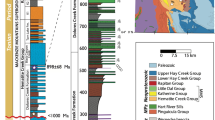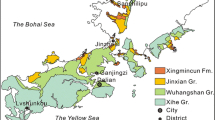Abstract
Precambrian fossils are crucial for our understanding of the evolution of early organisms. Megascopic body fossils are more important because they potentially represent macroorganisms. However, the Precambrian fossil record is sparse and dominated by microfossils and microbial structures. Here we show a new type of megascopic fossils recovered from the Xingmincun Formation (probably Neoproterozoic age), northeastern China. The specimens are flat, flexible (easily corrugated) and discoidal in outline. Concentric or spiral ridges are preserved on both sides. Petrographical thin section examination indicates that the specimen consist of a thin layer of microcrystalline quartz grains (about 20–30 μm thick) wrapped by an outer sheath, composed primarily of chlorites. Field Emission Scanning Electron Microscopy (FE-SEM) coupled with an x-ray energy dispersive spectrometer system (EDX) analysis shows microstructures and relative element abundance of the fossils, but contributes little in solving their biological affinities. The fossils have previously been linked to discoidal impressions of the Ediacara biota. Close examination on new materials indicates that they are radically different from either the Ediacara impressions or any other Precambrian megascopic remains. Concentric or spiral ridges may result from rhythmic growth and the presence of twin specimens may suggest that the organisms undergo asexual reproduction or inhibition of growth in one direction. Referring them to any known fossil or living group has proved to be difficult. We conclude that they represent a distinct group of Precambrian megascopic organisms regardless of their affinities remaining problematic.








Similar content being viewed by others
References
Bengtson S, Budd G (2004) Comment on small bilaterian fossils from 40 to 50 million years before the Cambrian. Science 306:1291
Brusca RC, Brusca GJ (2003) Invertebrates. Sinauer Assoc, Inc, Sunderland, 936 pp
Butterfield NJ (2000) Bangimorpha pubescens n. gen., n. sp.; implication for the evolution of sex, multicellularity, and the Mesoproterozoic/Noeproterozoic radiation of eukaryotes. Paleobiology 26:386–404
Chang SQ (1980) Subdivision and correlation of late Precambrian of southern Liaodong Peninsula. In: Xing YS (ed) Sinian. Tianjing Sci Tech Press, pp 266–287
Chen JY, Bottjer DJ, Oliveri P, Dornbos SQ, Gao F, Ruffins S, Chi HM, Li CW, Davidson EH (2004) Small bilaterian fossils from 40 to 55 million years before the Cambrian. Science 305:218–222
Chen ME (1991) Discussion on the stratigraphic significance of macrofossils from the late Precambrian sequences in the southern Liaoning Province. Acta Geol Sinica 65:120–128
Chen Z, Sun WG (2001) Late Sinian (tubular) metazoan fossils: Cloudina and Sinotubulites from southern Shaanxi. Acta Micropalaeont Sinica 18:180–202
Crimes TP, Insole A, Williams BPJ (1995) A rigid-bodied Ediacaran biota from Upper Cambrian strata in Co. Wexford, Eire. Geol J 30:89–109
Culver SJ (1993) Foraminifera. In: Lipps JH (ed) Fossil prokarotes and protists. Blackwell Sci Publ, Boston, pp 203–247
Ding LF, Li Y, Hu XS, Xiao YP, Su CQ, Huang JC (1996) Sinian Miaohe biota. Geol Publ House, Beijing, 221 pp
Du RL, Wang QZ, Tian LF (1995) Catalogue of algal megafossils from the Proterozoic of China. Precambrian Res 73:291–298
Ellis MB, Ellis JP (1990) Fungi without gills. Chapman and Hall, London, 212 pp
Evans DAD (2000) Stratigraphic, geochronological, and paleomagnetic constraints upon the Neoproterozoic climatic paradox. Am J Sci 300:347–433
Fedonkin MA (1990) Systematic description of Vendian Metazoa. In: Sokolov BS, Ivanovskij AB (eds) The Vendian System: Palaeontology. Springer, Berlin Heidelberg New York, pp 71–120
Fedonkin MA (1992) Vendian fauna and the early evolution of Metazoa. In: Lipps JH, Signor PW (eds) Origin and early evolution of the Metazoa. Plenum, New York, pp 87–129
Fedonkin MA, Yochelson EL (2002) Middle Proterozoic (1.5 Ga) Horodyskia moniliformis Yochelson and Fedonkin, the oldest known tissue-grade colonial eucaryote. Smithsonian Contr Paleobiol 94:1–29
Gehling JG, Narbonne GM, Anderson MM (2000) The first named Ediacaran body fossil, Aspidella terranovica. Palaeontology 43:427–456
Germs GJB (1972) New shelly fossils from Nama Group, southwestern Africa. Am J Sci 272:752–761
Glaessner MF (1984) The dawn of animal life: A biohistorical study. Cambridge Univ Press, Cambridge, 244 pp
Grant SW (1990) Shell structure and distribution of Cloudina, a potential index fossil for the terminal Proterozoic. Amer J Sci 290:261–294
Grazhdankin DV (2003) Ediacaran microbial colonies. Palaeont Newsl 54:130–131
Han TM, Runnegar B (1992) Megascopic eukaryotic algae from the 2.1 billion-year-old Negaunee Iron-Formation, Michigan. Science 257:232–235
Hoffman PF, Schrag DP (2002) The snowball Earth hypothesis: testing the limits of global change. Terra Nova 14:129–155
Hofmann HJ (1994) Proterozoic carbonaceous compressions (“metaphytes” and “worms”). In: Bengtson S (ed) Early life on earth. Columbia Univ Press, New York, pp 342–357
Hong ZM, Huang ZF, Yang XD, Lan J, Xian BC, Yang YJ, Liu XL (1988) Medusoid fossils from the Sinian Xingmincun Formation of southern Liaoning. Acta Geol Sinica 62:200–209
Jensen S, Gehling JG, Droser ML, Grant SWF (2002) A scratch circle origin for the medusoid fossil Kullingia. Lethaia 35:291–299
Keller BM, Menner VV, Stepanov VA Chumakov NM (1974) New finds of fossils in the Precambrian Valday Series along the Syuzma River. Izvestia Akademii Nauk Sssr, Seriya Geologicheskaya 12:130–134
Mankiewicz C (1992) Proterozoic and Early Cambrian calcareous algae. In: Schopf JW, Klein C (eds) The Proterozoic biosphere: a multidisciplinary study. Cambridge Univ Press, Cambridge, pp 359–367
Molitoris HP, Schaumann K (1986) Physiology of marine fungi: A screening programme for growth and enzyme production. In: Moss ST (ed) The biology of marine fungi. Cambridge Univ Press, Cambridge, pp 35–47
Narbonne GM, Hofmann HJ (1987) Ediacaran biota of the Wernecke Mountains, Yukon, Canada. Palaeontology 30:647–676
Pawlowski J, Holzmann M, Berney C, Fahrni J, Gooday AJ, Cedhagen T, Habura A, Bowser SS (2003) The evolution of early Foraminifera. Proc Natl Acad Sci USA 100:11494–11498
Peterson KJ, Waggoner B, Hagadorn JW (2003) A fungal analog for Newfoundland Ediacaran fossils? Integrative and Comparative Biol 43:127–136
Purvis OW (2000) Lichens. Smithsonian Inst Press, Washington, DC, 104 pp
Rasmussen B, Bengtson S, Fletcher IR, McNaughton N (2002) Discoidal impressions and trace-like fossils more than 1200 million years old. Science 296:1112–1115
Ray JS, Martin MW, Veizer J, Bowring SA (2002) U-Pb zircon dating and Sr isotope systematics of the Vindhyan Supergroup, India. Geology 30:131–134
Retallack GJ (1994) Were the Ediacaran fossils lichens? Paleobiology 20:523–544
Schulz HN, Brinkhoff T, Ferdelman TG, Mariné MH, Teske A, Jørgensen BB (1999) Dense populations of a giant sulfur bacterium in Namibian shelf sediments. Science 284:493–495
Seilacher A (1992) Vendobionta and Psammocorallia: lost constructions of Precambrian evolution. J Geol Soc Lond 149:607–613
Seilacher A, Bose PK, Pflüger F (1998) Triploblastic animals more than 1 billion years age: trace fossil evidence from India. Science 282:80–83
Stanley GDJ (1986) Chondrophorine hydrozoans as problematic fossils. In: Hoffman A, Nitecki MH (eds) Problematic fossil taxa. Oxford Univ Press, Oxford, pp 68–86
Steiner M (1994) Die neoproterozoischen Magaalgen Südchinas. Berliner Geowiss Arb E 15:1–146
Sun WG (1987) Palaeontology and biostratigraphy of late Precambrian macroscopic colonial algae: Chuaria Walcott and Tawuia Hofmann. Palaeontographica B 203:109–134
Sun WG (1998) Primitive Ediacara-type fossils from the late Proterozoic Xingmincun Formation in northeastern China. In: Gehling JG (ed) Inaugural Sprigg Symposium: the Ediacaran revolution. Geol Soc Austr, Abstract No 51
Talyzina NM (2000) Ultrastructure and morphology of Chuaria circularis (Walcott, 1899) Vidal and Ford (1985) from the Neoproterozoic Visingsö Group, Sweden. Precambrian Res 102:123–134
Tendal OS (1972) A monography of the Xenophyophoria. Galathea Rep 12:7–99
Thomas DN (2000) Seaweeds. Smithsonian Inst Press, Washington, DC, 102 pp
Towe KM, Bengtson S, Fedonkin MA, Hofmann HJ, Mankiewicz C, Runnegar BN (1992a) Proterozoic and earliest Cambrian carbonaceous remains, trace and body fossils. In: Schopf JW, Klein C (eds) The Proterozoic biosphere: A multidisciplinary study. Cambridge Univ Press, Cambridge, pp 343–424
Towe KM, Bengtson S, Fedonkin MA, Hofmann HJ, Mankiewicz C, Runnegar BN (1992b) Described taxa of proterozoic and selected earliest Cambrian carbonaceous remains, trace and body fossils. In: Schopf JW, Klein C (eds) The Proterozoic biosphere: a multidisciplinary study. Cambridge Univ Press, Cambridge, pp 954–1053
Waggoner B, Collins AG (2004) Reductio ad absurdum: testing the evolutionary relationships of Ediacaran and Paleozoic problematic fossils using molecular divergence dates. J Paleontol 78:51–61
Wood RA, Grotzinger JP, Dickson JAD (2002) Proterozoic nodular biomineralized metazoan from the Nama Group, Namibia. Science 296:2283–2286
Xiao SH (2002) Macroscopic carbonaceous compressions in a terminal Proterozoic shale: a systematic reassessment of the Miaohe biota, South China. J Paleontol 76:347–376
Xing YS, Liu GZ (1979) Coelenterate fossils from the Sinian System of southern Liaoning and its stratigraphical significance. Acta Geol Sinica 53:167–172
Yang XD, Li XY, Sun JS, Huan YQ, Yang YJ, Zhan LQ, Quan XJ, Chen YD, Xu AT, Zhang FS (eds) (1997) Multiple classification and correlation of the stratigraphy of China 21: lithostratigraphy of Liaoning Province. China Univ Geosci Press, Wuhan, 234 pp
Yochelson EL, Fedonkin MA (2000) A new tissue-grade organism 1.5 billion years old from Montana. Proc Biol Soc Washington, DC 113:843–847
Zhu SX, Sun SF, Huang XG, He YZ, Zhu GX, Sun LX, Zhang K (2000) Discovery of carbonaceous compressions and their multicellular tissues from the Changzhougou Formation (1800 Ma) in the Yanshan range, North China. Chinese Sci Bull 45:841–846
Zhuravlev AY (1993) Were Ediacaran Vendobiota multicellulars? N Jb Geol Paläont 190:299–314
Acknowledgements
We thank D. H. Erwin, E. L. Yochelson, N. J. Butterfield, S. Conway Morris, G. M. Narbonne, G. E. Budd, J. Hannibal, J. G. Gehling, M. Steiner and G. Helmus for scientific discussions, X.-D. Li, Y.-J. Yang, G.-R. Zhang, B. Zhou and W. Bai for field assistance, and G. Hundertmark for technical assistance. We are also grateful to M. Wilmsen and an anonymous referee for reviewing the manuscript. XZ appreciates the Alexander von Humboldt Foundation for the financial support of one-year research stay in Germany. Grants from the Natural Science Foundation of China (NSFC 40402005 and 40332016) and a Foundation for the Author of National Excellent Doctoral Dissertation of PR China (FANEDD 200326) are gratefully acknowledged.
Author information
Authors and Affiliations
Corresponding author
Rights and permissions
About this article
Cite this article
Zhang, X., Hua, H. & Reitner, J. A new type of Precambrian megascopic fossils: the Jinxian biota from northeastern China. Facies 52, 169–181 (2006). https://doi.org/10.1007/s10347-005-0027-z
Received:
Accepted:
Published:
Issue Date:
DOI: https://doi.org/10.1007/s10347-005-0027-z




